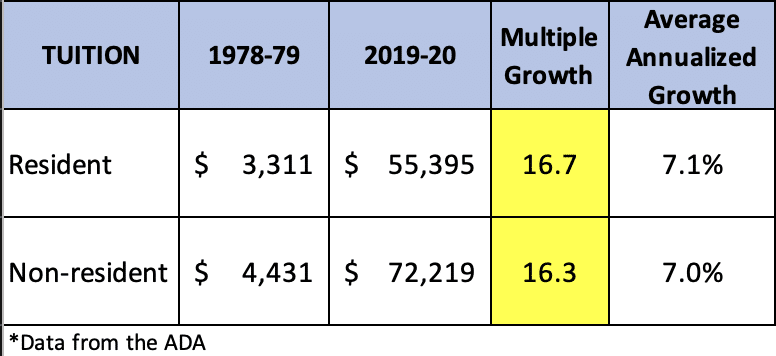Inflation continues to affect all aspects of the dental industry. This part of our economic reality is a well-worn talking point by now: everything continues to get more expensive, and at an exponential rate. Soaring costs associated with the pandemic and supply chain disruption have not ebbed and returned to normal. As we get back to business as usual, our expenses are anything but normal.
For those who are already established in a dental practice, the costs at the front of mind are probably supplies, disposable hygiene products, and new technology–costs that continue to grow month over month.

However, for those still in school who are considering a career in dentistry, there is a different (but related) question: can my salary as a dentist offset the rising costs of dental school?
Before turning to financial planning, Dr. Tyler Scott started his career as a public health dentist, which he still strongly recommends as a viable career.
Is Dentistry Worth It?
Dr. Tyler Scott started his career as a public health dentist before turning to financial planning. In a recent article for White Coat Investor, he says his change in vocation came as a result of his shifting intellectual interests and physical limitations, but he is proud to be a dentist and strongly recommends it as a viable career for young people exploring their future plans.
However, he notes that there are significant costs to investing in a career as a dentist. “In other words,” Dr. Scott says, “I’m trying to answer the question, ‘Is dentistry worth it financially, compared to other careers?’”
The Costs of Dental School
According to StudentLoanPlanner.com, dental school tuition in 1978 averaged less than $5,000 per year: $3,311 for resident tuition and $4,431 for non-resident tuition. A 1979 report from the Council on Dental Education states that, at the time, only 59 dental schools were fully operational, while Oral Roberts University was accepting its first dental class that would make it the 60th dental school.
Even in ‘79, falling dental school admission rates were a concern. According to the Council on Dental Education report, “The number of candidates participating in the Dental Admission Testing Program in the past three years has declined sharply— from the high of 21,367 in the 1974-1975 academic year to 14,467 in the past year (Fig 1).”

How Do Salaries Compare Across Decades?
These concerns about rising costs and falling dental school admission numbers have resurfaced in recent years. Per the American Dental Association, for the 2019-2020 school year, the average first year tuition was $55,395 for residents and $72,219 for non-resident dental students. Dental school is now 16 times more expensive than it was. This marks an average 7% growth rate in tuition from 1979 until now.
And how about dentist salaries? How do rising dentist incomes compare to the cost of school?
Dentists’ salaries, according to St. Louis Fed data, were roughly $50,000 in 1980. Compared with today’s average dentist salary of $164,010. Average annual salary growth has stayed below 3%–less than half of the percentage increase in dental school tuition.
Over the last 40 years, dentist income has risen 3x, but the cost of tuition has risen 16x. This far outstrips the general inflation rate on things like cars, homes, and general goods (somewhere between 3.7x and 6.2x).
40 years ago, dentistry was a much more affordable educational investment. However, inflation continues to impact all career fields.

All this math boils down to one basic observation: 40 years ago, dentistry was a much more affordable educational investment. However, inflation has impacted all career fields. Before we dismiss the viability of dentistry as a vocation, we have to look at the big picture?
Is dental school still worth it?
Dentistry As An Investment
Dr. Scott uses his expertise in finance to turn the idea of pursuing a career in dentistry into an investment. His approach involves analyzing Net Present Value (NPV) and Internal Rate of Return (IRR) for various careers—plumber, certified financial planner, mechanical engineer, physician assistant, dentist, lawyer, veterinarian, pediatrician, emergency medicine physician, and orthopedic surgeon. Then, he uses these two related financial concepts to compare this investment (being a dentist) to other similar investments (training in some other profession).
Simply put, NPV is your expected income minus the investment in education. IRR is the expected annual rate of return on your investment (in this case, the investment in question is your investment in a career path).
Using his technical mind, Dr. Scott seeks to strip away subjective elements and focus on numerical data to answer whether dentistry stands out financially when compared with other careers. These numbers are obviously estimates, and they exclude many of the complicating and contributing financial factors (marginal tax rates, spending behavior, business plans, etc.).
Dentistry remains more profitable than many other fields. Despite the major shift in the industry over the last few decades, dentistry has a lot going for it.
Dr. Scott’s results, after running several careers through his formula, indicates that dentistry is exactly as viable and profitable a career path as being a lawyer. Certain careers, like financial planning, engineering or orthopedic surgery, appear to have higher ceilings and higher rates of return on educational investment.
Dentistry, however, remains more profitable than many other fields. Despite the major shift in the industry over the last few decades, dentistry has a lot going for it.
Opening Your Own Dental Practice
One major factor in the viability of dentistry as a career is the opportunity to open your own practice. Many careers prepare you to practice in a field. For many dentists, their career path involves opening their own practice and then expanding to other operatories.
Dentists venturing into their own dental practice can bring tremendous benefits. Owning a practice allows dentists to control their work environment, shaping it to fit their vision and patient care goals. They have the autonomy to set their schedule, choose the services they offer, and create a welcoming atmosphere for patients.
Further, owning a practice offers financial rewards. While it requires initial investment and management skills, the long-term financial prospects can be promising. By managing their practice, dentists retain the earnings that might otherwise go to an employer. Successful practices also grow, expanding services and reaching more patients, increasing income potential. This financial independence allows dentists to invest in advanced technology or additional staff, expanding the ways they grow.
Turning Challenges into Profits
However, opening a dental practice involves challenges. It demands business acumen alongside dental expertise. Dentists must navigate administrative tasks, such as hiring staff, managing finances, and marketing their practice. Balancing these responsibilities can be demanding, requiring dedication and a willingness to learn beyond clinical skills. Despite the hurdles, the rewards of owning a dental practice often extend beyond financial gains, offering professional fulfillment and the chance to make a meaningful impact on patients’ oral health.
Are you looking to open your own practice, or expand your existing practice to new operatories? Benco’s Practice Lifecycle team can guide you every step of the way, from initial concept to practice design to execution and installation. Contact Benco today and let us help you maximize the potential of your dental practice in every phase, at every turn.


